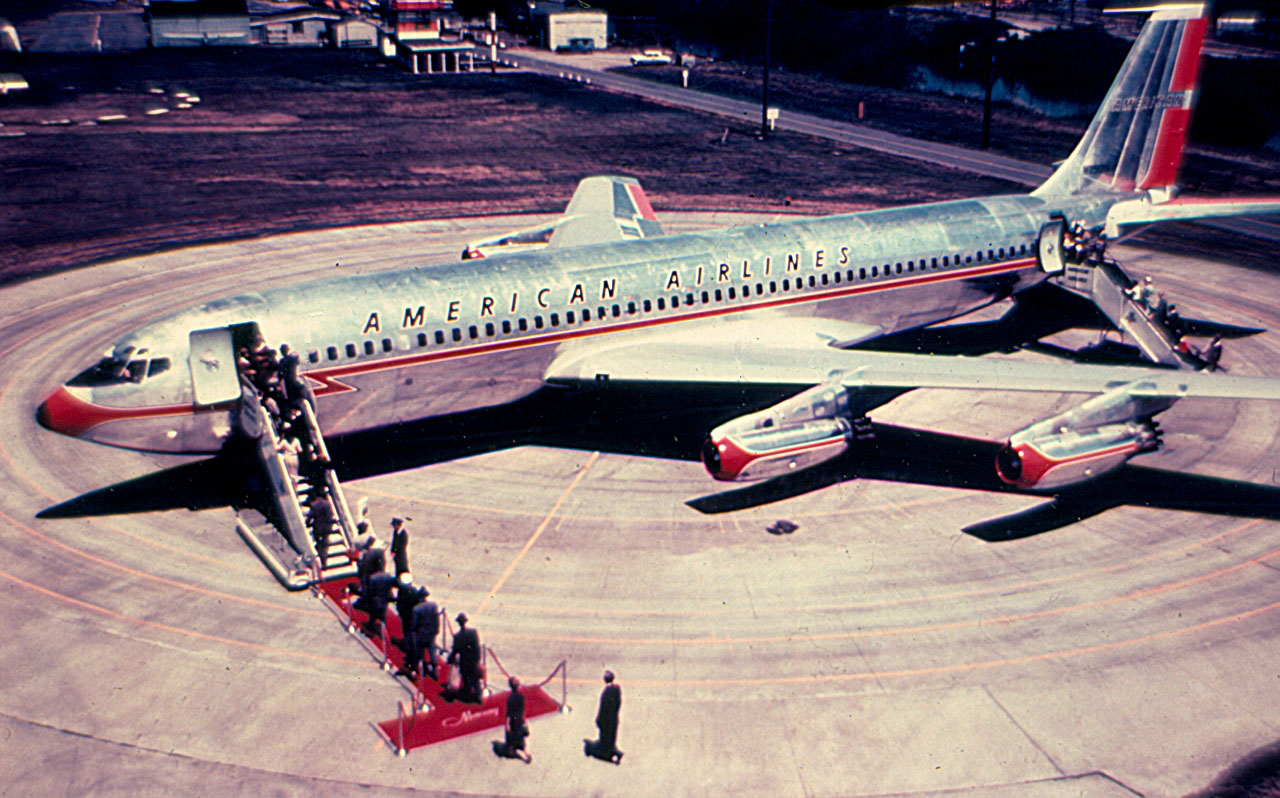
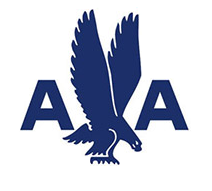 25 January 1959: “The Jet Age” opened when American Airlines began the first scheduled transcontinental passenger service with its new Boeing 707-123 Astrojet. Captain Charles A. Macatee III flew Flagship California, N7503A, from Los Angeles International Airport on the coast of southern California, to New York International Airport ¹ in New York City, in 4 hours and 3 minutes.
25 January 1959: “The Jet Age” opened when American Airlines began the first scheduled transcontinental passenger service with its new Boeing 707-123 Astrojet. Captain Charles A. Macatee III flew Flagship California, N7503A, from Los Angeles International Airport on the coast of southern California, to New York International Airport ¹ in New York City, in 4 hours and 3 minutes.
Other members of the inaugural flight crew were Captain Lou Szabo, Flight Engineer William J. Duncan, Flight Engineer Norman S. Rice, Stewardess Claire Bullock, Stewardess Edna Garrett, Stewardess Argie Hoskins and Stewardess Marilyn Rutkowski. Cyrus Rowlett Smith, president of the airline, was also aboard as a passenger.
The flight departed LAX via Runway 25 at 9:05 a.m., Pacific Standard Time. Ceremonies at the airport, with as many as 25,000 spectators, delayed the flight by twenty minutes, but a 150 knot (278 kilometers per hour) tailwind allowed the flight to make up for the lost time and they arrived at Idlewild Airport on schedule.
Flagship California returned to Los Angeles the same day. Flown by Captain Hamilton C. Smith, the 707 departed Idlewild at 6:26 p.m., Eastern Standard Time, arriving at LAX 6 hours, 33 minutes later.
This flight was so significant that rival airlines, such as B.O.A.C. and Pan Am took out full-page newspaper advertisements congratulating American Airlines on its inaugural jet flight.
Ticket prices for one-way, First Class, were $198.88, and $124.40 for coach. Eastbound passengers included actress Jane Wyman and World War II fighter pilot, Brigadier General Robert Lee Scott, Jr., author of God is My Co-Pilot. Poet Carl Sandburg flew on the westbound return flight.
Prior to the first passenger flight, Captain Macatee and Captain Smith had flown the Boeing 707 for 200 hours. In an interview thirty years later, Macatee remarked, “But those four hours three minutes were the big ones for me. They always will be.”
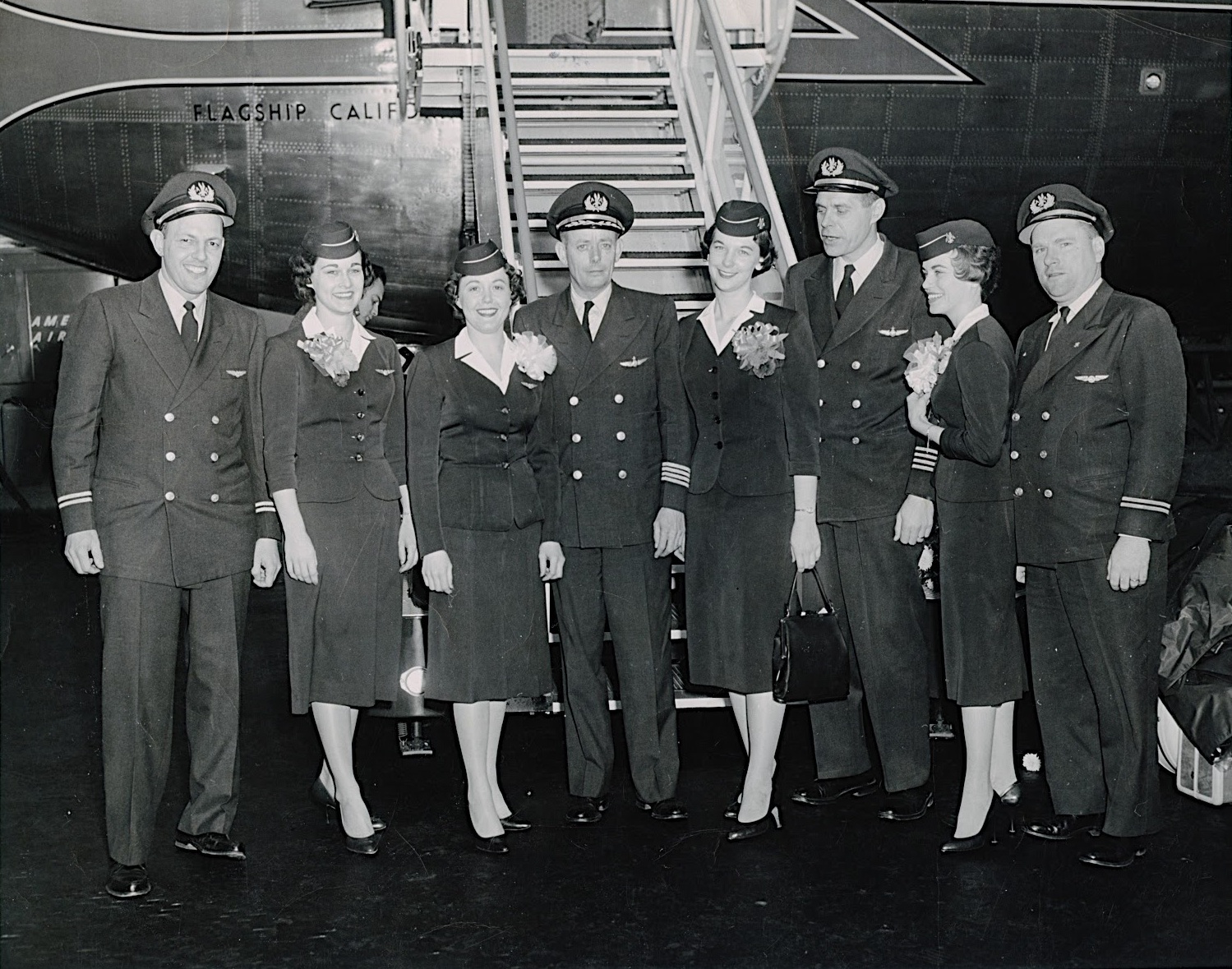
![]() The Boeing 707 was developed from the earlier Model 367–80, the “Dash Eighty.” It is a four-engine jet transport with swept wings and tail surfaces. The leading edge of the wings are swept at a 35° angle. The airliner had a flight crew of four: pilot, co-pilot, navigator and flight engineer. The airliner could carry a maximum of 189 passengers.
The Boeing 707 was developed from the earlier Model 367–80, the “Dash Eighty.” It is a four-engine jet transport with swept wings and tail surfaces. The leading edge of the wings are swept at a 35° angle. The airliner had a flight crew of four: pilot, co-pilot, navigator and flight engineer. The airliner could carry a maximum of 189 passengers.
The 707-123 was 145 feet, 1 inch (44.221 meters) long with a wing span of 130 feet, 10 inches (39.878 meters). The top of the vertical fin stood 42 feet, 5 inches (12.929 meters) high. The 707 pre-dated the ”wide-body” airliners, having a fuselage width of 12 feet, 4 inches (3.759 meters). The airliner’s empty weight is 122,533 pounds (55,580 kilograms). Maximum take off weight is 257,000 pounds (116,573 kilograms).
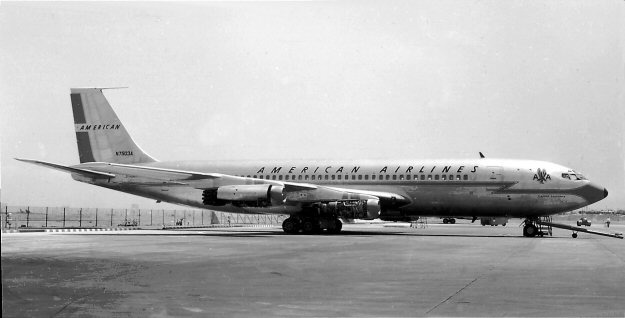
 The first versions were powered by four Pratt & Whitney Turbo Wasp JT3C-6 turbojet engines, producing 11,200 pounds of thrust (49,820 kilonewtons), and 13,500 pounds (60.051 kilonewtons) with water injection. This engine was a civil variant of the military J57 series. It was a two-spool axial-flow turbojet engine with a 16-stage compressor and 2 stage turbine. The JT3C-6 was 11 feet, 6.6 inches (3.520 meters) long, 3 feet, 2.9 inches (0.988 meters) in diameter, and weighed 4,235 pounds (1,921 kilograms).
The first versions were powered by four Pratt & Whitney Turbo Wasp JT3C-6 turbojet engines, producing 11,200 pounds of thrust (49,820 kilonewtons), and 13,500 pounds (60.051 kilonewtons) with water injection. This engine was a civil variant of the military J57 series. It was a two-spool axial-flow turbojet engine with a 16-stage compressor and 2 stage turbine. The JT3C-6 was 11 feet, 6.6 inches (3.520 meters) long, 3 feet, 2.9 inches (0.988 meters) in diameter, and weighed 4,235 pounds (1,921 kilograms).
At MTOW, the 707 required 11,000 feet (3,353 meters) of runway to take off.
The 707-121 had a maximum speed of 540 knots (1,000 kilometers per hour). It’s range was 2,800 nautical miles (5,186 kilometers).
The Boeing 707 was in production from 1958 to 1979. 1,010 were built. Production of 707 airframes continued at Renton until the final one was completed in April 1991.
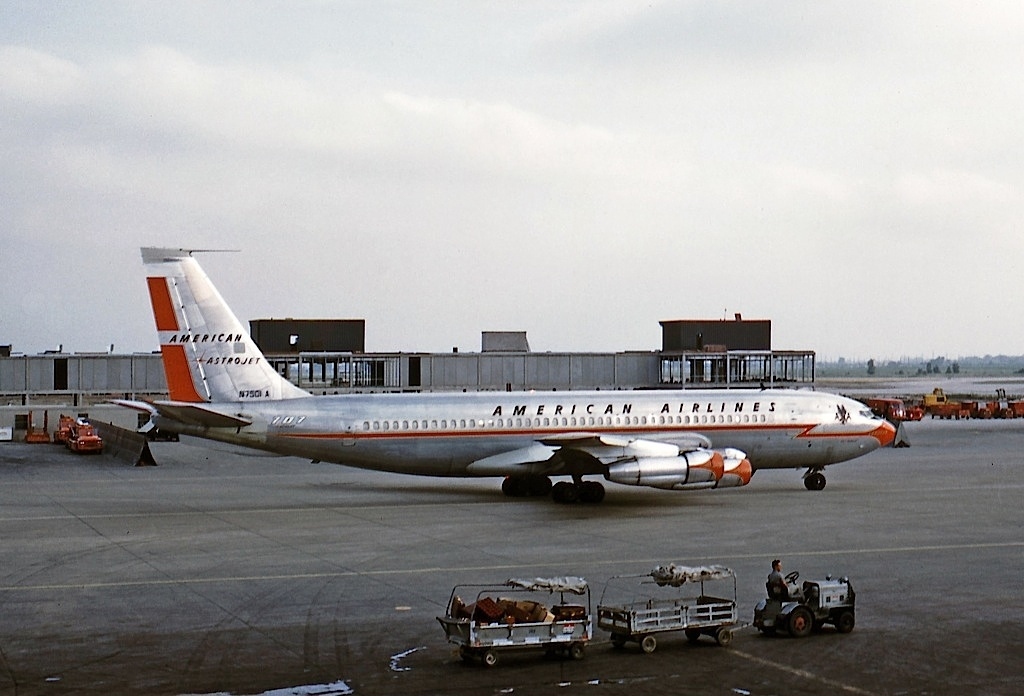
In 1961, N7503A was upgraded to the 707-123B standard. This included a change from the turbojet engines to quieter, more powerful and efficient Pratt & Whitney JT3D-1. The JT3D-1 was a dual spool axial-flow turbofan engine, with a 2-stage fan section, 13-stage compressor (6 low- and 7 high pressure stages), 8 combustion chambers and a 4-stage turbine (1 high- and 3 low-pressure stages). This engine was rated at 14,500 pounds of static thrust (64.499 kilonewtons) at Sea Level, and 17,000 pounds (75.620 kilonewtons), with water injection, for takeoff (2½ minute limit). Almost half of the engine’s thrust was produced by the fans. Maximum engine speed was 6,800 r.p.m. (N1) and 10,200 r.p.m. (N2). It was 11 feet, 4.64 inches (3.471 meters) long, 4 feet, 5.00 inches (1.346 meters) wide and 4 feet, 10.00 inches (1.422 meters) high. It weighed 4,165 pounds (1,889 kilograms). The JT3C could be converted to the JT3D configuration during overhaul.
The 707-123B wings were modified to incorporate changes introduced with the Boeing 720, and a longer tailplane installed.
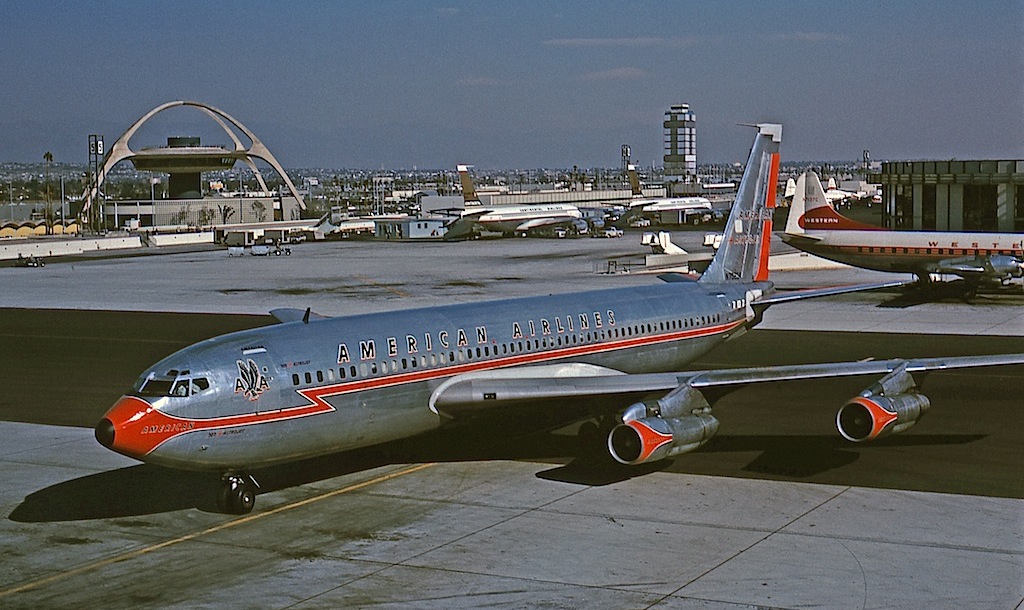
N7503A was damaged at Dyess Air Force Base, Texas, 9 May 1965.² It had flown through a violent thunderstorm shortly after leaving Dallas and suffered hail damage. The crew made a precautionary landing, however the windshield had been crazed so badly by the impact of hail that it was opaque. The 707 made a hard landing and its gear collapsed. There were no injuries among the 89 passengers and 7 crewmembers. It was repaired and returned to service.
After 28 years, American Airlines’ inaugural Astro Jet was scrapped.
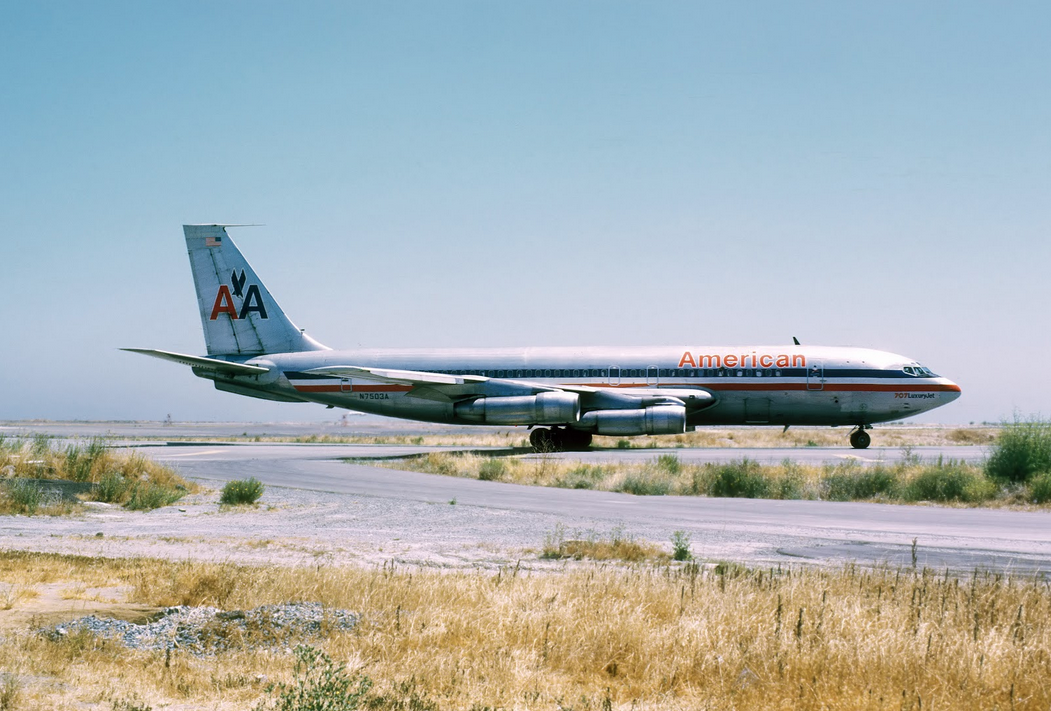
¹ New York International Airport, located in Queens, a borough of New York City, was commonly called Idlewild Airport. In 1963, the name was changed to John F. Kennedy International Airport (JFK).
² Jet Forced Into Landing
ABILENE (AP) — An American Airlines 707 Astrojet made an emergency landing at Dyess Air Force Base Sunday after its nose radar was knocked out by a hail and thunderstorm.
The 87 passengers and seven crew members were not injured, although the big jet broke its front wheel in landing.
The pilot, Capt. E. V. Cook, said hail had damaged the windshield and impaired his vision. Air Force emergency crews stood by but were not needed.
The plane was American Airlines Flight 33 from Dallas to Los Angeles.. Cook said he hit turbulent weather about ten minutes out of Dallas. Skies were partly cloudy at Abilene when the plane landed.
Passengers were taken to the Dyess Officers’ club to await another plane.
—Tyler Morning Telegraph, Vol. 37, No. 175, Monday 10 May 1965, Page 2, Column 4
© 2023, Bryan R. Swopes
Hello
I am a little confused. What aspect of the jet age are we talking about here?
The ‘jet age’ in the airline world should more accurately be said to have started in 1952 with the first scheduled service by the British Comet. Aeroflot started in 1956 with the TU-104. Even regular transatlantic jet services started by BOAC and PanAm in 1958.
Keep up the good work, I am enjoying the articles.
This is not the first time this subject has come up. The term “Jet Age” refers to a period of societal transformation, and is not defined by specific technological events. (Frank Whittle’s WU turbojet engine was the first, in 1937, while the first turbojet-powered airplane was the Heinkel He 178, which flew in 1939.)
According to the Smithsonian Institution National Air and Space Museum, the “Jet Age” began in 1958 when Pan Am introduced the Boeing 707. You are correct that the de Havilland Comet flew in scheduled passenger service before the Boeing 707, but in only limited numbers. It’s several catastrophic failures severely damaged its reputation and the entire Comet 1 fleet was permanently grounded and its type certificate revoked in 1954, just two years after it entered service. Orders for the Comet 2 were canceled. There were only two Comet 3s, which were never in airline service. The Comet 4 didn’t enter service until 4 October 1958, and only 18 were built.
In the decade following World War II, the vast majority of people crossing the Atlantic Ocean traveled aboard ocean liners. It wasn’t until the Boeing 707 entered service that airliners flying across the Atlantic Ocean carried more passengers than did the passenger ships.
The Boeing 707 forever changed the way that most people traveled long distances. The Comet did not.
Just curious why LAX to JFK flights take so much longer more than a half a decade later? Generally, the flight is 5 1/2 hours. Seems like we are going backwards even with more powerful, more efficient technology?
Airliner flight times are determined by Air Traffic Control. They must be kept separate by specified distances/times, and the timing of aircraft landing and taking off from the destination airport.
Another reason (and likely the most important) is that jet fuel costs so much more now, so the aircraft fly at a lower Mach number. Back in the ’80s when I became a controller, it was common to see ground speeds much higher than we do today. It’s all done to save fuel.
Actually there is a reason for that. First of all, eastbound will always be faster than westbound due to upper level winds that run west to east. Secondly, today’s aircraft are designed with economy, rather than speed and comfort in mind. An Airbus A321 flies at approximately Mach .75 (or 75% the speed of sound), whereas 707s, 747s and L1011s of that generation COULD exceed Mach .90 (90% of the speed of sound). There are still some faster planes out there. Most 777s and 787s fly between M.84 and M.86. But those are usually for longhaul service.
Airliners frequently operate at speeds considerably lower than they are capable of. This is because of the limited capacity of airspace and airports.
And here I, Argie Hoskins, who was one of the four stewardesses on the first American Airlines Boeing 707 on that exciting day of 25, January 1959, sitting here at age 87 and wondering who is celebrating the day which is warmly wrapped in my heart. I still smell the flowers as I boarded the jet for the flight. Flowers plus our passengers, our honored guest enjoyed this flight. See my picture with the crew. The agent who met the plane in New York just recently passed away to our home in the sky. Love my friends. Thanks for still enjoying these historical moment in time. Argie Hoskins
Thank you for your recollections, Ms. Shumway.
Bless you and congratulations, Argie, from an old Braniff pilot. Those certainly were great days.
Wow! As an active aeronautical engineer with 42+ years in the aerospace industry all I can say briefly is the pioneers of the jet age are very appreciated.
Hello, Bryan, and THANKS for the wonderful job you do with this website. I’m a (very) amateur aviation historian, and wonder if you have any additional information on the N7503A incident at Mineral Wells, TX. I live in Ft. Worth, just about 20 miles east of Mineral Wells, and flew as a private pilot for some years, mostly in the surrounding area. I’d never heard of this incident before, and was intrigued. Measuring the longest of the two runways at the current Mineral Wells muni airport, the longest only measures slightly >5,000 ft., and I’d bet money that it wasn’t that long in 1965. As you likely know, the old Ft. Wolters US Army helo training base (Vietnam era) was nearby, and it’s possible that they had a runway for fixed-wing A/C, but I doubt that, as I’d have surely heard of it in the past. Anyway, am very curious whether they repaired the A/C on-site & flew it out of there (that would have been hairy, even with a light fuel load & possibly influenced by density altitude, depending on air temperatures that day) – or whether it was disassembled & moved to another field with a longer runway, like the nearby old Carswell AFB. Any clarification / additional info would be welcomed! Cheers, Brian
I don’t really know anything more about the incident. It has been more than four years since I wrote the article and I don’t recall the source for the information. I checked with newspapers.com and found a short notice in the Tyler TX Morning Telegraph for 10 May 1965:
Jet Forced Into Landing
ABILENE (AP) — An American Airlines 707 Astrojet made an emergency landing at Dyess Air Force Base Sunday after its nose radar was knocked out by a hail and thunderstorm.
The 87 passengers and seven crew members were not injured, although the big jet broke its front wheel in landing.
The pilot, Capt. E. V. Cook, said hail had damaged the windshield and impaired his vision. Air Force emergency crews stood by but were not needed.
The plane was American Airlines Flight 33 from Dallas to Los Angeles.. Cook said he hit turbulent weather about ten minutes out of Dallas. Skies were partly cloudy at Abilene when the plane landed.
Passengers were taken to the Dyess Officers’ club to await another plane.
—Tyler Morning Telegraph, Vol. 37, No. 175, Monday 10 May 1965, Page 2, Column 4
Many thanks for the additional info / clarification, Bryan!!
Dyess AFB is at Abilene. You’re right Ft. Wolters is at M.W. Dyess at the time of the incident either still had or just lost the B-47. Most SAC bases at that time had 12,000 + ft. runways.
I was born on that day month year 1/25/1959 and became a A&P tech & avionics tech for Texas International, Continental airlines merged with United 40 plus year of service.